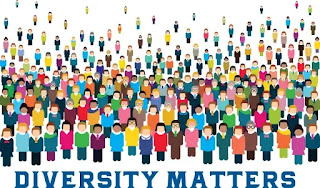sd719116@ohio.edu
 |
| Source: championsofdiversity.info |
There are so many stories that have been denied the right to be told because those would have told these stories were not born the "right" race or gender.
Journalism has often been described as a form of storytelling. So, as journalists and as storytellers, we can no longer allow this to go on.
Truth knows no race, gender or sexual orientation. So we as journalists cannot force it to have such.
As written by Jelani Cobb, "The people who are most likely to appear in these kinds of stories are the least likely to have a say in how those stories are told."
In the article where Cobb wrote that quote, he discusses his reaction to a story about a robbery in a primarily black and Latinx community. In the article, Cobb explains how this community was inaccurately represented because those who worked on the story were white and did not understand what it was like to live in that community.
Having a diverse newsroom means having different writers with different perspectives that can hold their fellow journalists accountable to ensure that the content the media outlet puts forth is accurate and truthful. There is no other way.
2. Regardless of their own identity, journalists need to be aware of their personal stereotypes.
"It's not an easy task. But it is a necessary one if we intend to be part of the solution, rather than the problem," says Dawn Turner in her article "Journalists Must Train Their Brains to See Beyond Stereotypes."
We all stereotype, and no matter our class, gender or race there are certain stereotypes that have been ingrained in us as we have grown up. However, even though learning these stereotypes is often unavoidable, this is no excuse for these stereotypes to affect a journalist's job.
Luckily, there are resources such as Harvard University's "Project Implicit" where journalists can learn about their own personal biases and stereotypes so that they can be aware of their own personal stereotypes so they can keep them in check and ensure that their writing does not contain stereotypes.
Click here to check your own personal biases and stereotypes today.
3. The conversation regarding diversity as a "problem" needs to be changed.
As explained in Rochelle Newman-Carrasco's article, "our industry's impotence when it comes to dealing with structural racism and gender bias isn't a "problem," because if it were it would be fixed."
Newman-Carrasco then continues to explain that sexism and racism are rather systematic flaws in our society and often subjects that we as a society are uncomfortable talking about.
Journalists need to break that barrier of uncomfortableness. It is the journalist's job to be completely transparent and truthful. So if that means talking about uncomfortable topics such as racism and sexism, it is up to the journalist to write about the topic, to tell those stories that have been denied the right to be told for too long and to do it in a way that will promote and inspire change.
No comments:
Post a Comment